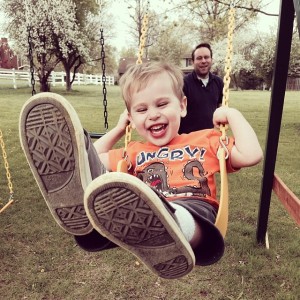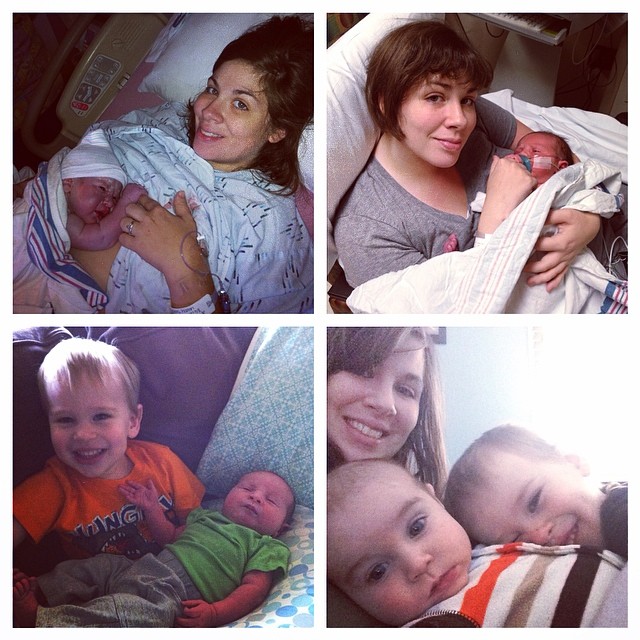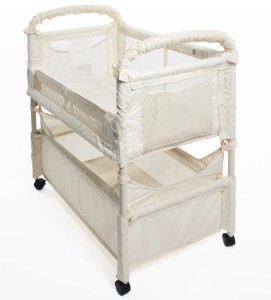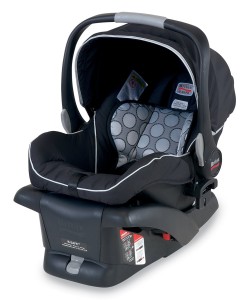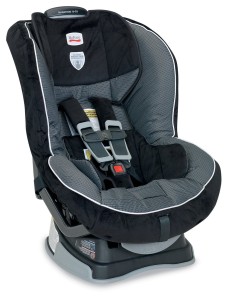 Judah has been showing interest in the potty for a couple months now, but mostly never did anything when we took him in there. Just a couple weeks ago he finally started acknowledging when he needed a new diaper, so I set a goal to start the process this month after my extended maternity leave began and while my husband was on vacation.
Judah has been showing interest in the potty for a couple months now, but mostly never did anything when we took him in there. Just a couple weeks ago he finally started acknowledging when he needed a new diaper, so I set a goal to start the process this month after my extended maternity leave began and while my husband was on vacation.
I considered several options for potty training undergarments — disposable Pull-Ups, expensive cloth trainers, cheap reusable cloth trainers, and some hybrid DIY cloth trainer options. But the majority of people who offered advice told me that going straight to underwear is the way to go. Anything else is just an expensive crutch that delays the inevitable. The idea of giving up diapers cold turkey terrified me — I imagined my expensive furniture covered in urine and ruined by the end of the first day — but the more I thought about it, the more sense it made.
After a little more research, I found a huge following for an intense method that people call “potty training boot camp.” There are lots of different versions of the method (Google search it for lots of different perspectives on the topic), but the most popular involves three days of intense, pantsless potty training at home followed by three months of no pants at home. I decided to modify it a bit and try it myself.
Protect your furniture.
First I had to take some precautions. We have laminate flooring, so accidents on the floor don’t concern me much. My furniture, on the other hand, is only a year old, and it was a huge investment for us. Our decision to spring for fancy slip-covered furniture actually paid off. We were able to wrap the cushions in large trash bags beneath the slip covers to protect them. The covers are 100% cotton and wash up like a dream, so I felt much better knowing that an accident could be quickly cleaned up without affecting the cushions beneath. We also put towels on top of the cushions in the hopes that we could catch small accidents without having to wash the covers every time. This step made the whole process feel a lot less stressful. If you have removable covers on your couch cushions, I highly recommend you do this!
Clear your calendar.
This potty training method relies on your commitment to stay home for at least three days. It is not easy. By the end of day 3, our whole family was going stir crazy. Staying home really did make all the difference, though. It gives the child a chance to build a solid foundation of learning without interruptions. We chose the long Memorial Day weekend, but my husband is also on vacation this week, so we knew we could take an extra couple days if necessary. Having backup was really helpful. You have to watch your toddler like a hawk the whole time, so a second pair of eyes is huge.
Throw away the diapers.
The next step is easy: say goodbye to diapers. That means Pull-Ups, too (during waking hours anyway). When your toddler wakes up on day 1, tell him or her that it’s time to wear underpants and go on the potty like a big boy/girl. Choose underwear that your toddler will like with fun characters on them to make it more exciting. Put them on your kid, and don’t look back!
Many people who use this method choose to let their toddler go bare-bottomed to make it easier for them to go. But there is also a downside to this — once the kid gets used to running around half naked, it’s an extra step to convince him to wear underwear or teach him to pull his pants down when it’s time to go. I also have enough trouble convincing Judah to wear pants at home — I didn’t want to encourage his natural inclination toward nudity. The other possible downside is that the toddler won’t feel as wet after accidents, which I think helps make the connection with how it feels when they need to go. Sure, there is more laundry to do, but those tiny underwear don’t take up much space in the washer. Plus the underwear will at least contain the poopy accidents somewhat.
Watch and remind.
The first day was extremely stressful. I tried to relax, but the truth is I was on edge, watching him like a hawk expecting an accident any minute. I used this free Potty Baby iPhone app to track when he used the potty and remind me to remind him. We started by reminding him every 15 minutes. We let him drink as many fluids as he wanted (I even allowed juice, which is usually a special treat). We only had a handful of accidents on day 1, but I was diligent. I put his potty right in the living room (I found it easier to have it front and center near where he was playing instead of all the way in the bathroom at the end of the hall). I asked him every 15-20 minutes if he needed to sit on the potty. If he said no, I encouraged him and bribed him with stickers or M&Ms — whatever it took to get him to sit down and go. We celebrated when he sat down and tried, and went bonkers when he succeeded.
We also found it helpful to watch the potty episodes of his favorite TV shows. This episode of “Daniel Tiger’s Neighborhood” — available on Amazon Prime Instant Watch for $1.99 — was particularly helpful for him. He liked to sing the little song when he was waiting on the potty, and he has been very adamant about washing his hands every time he goes. Bonus points for good hygiene!
What kind of potty seat is best?
Initially, I planned to use a small seat that fits on a regular toilet like those made by toto toilets. I thought it would be nice to eliminate the extra step of teaching him to use the big potty eventually. But I found that the small, standalone potty actually has a lot of benefits. First of all, it can be brought into the play space (if you’re not squeamish about having a toilet in your living room for a couple days). Just put a nice thick towel under it to protect the floor from accidents and dribble. It seemed to work as a good reminder for Judah to see the potty seat right where he was playing, and it was also closer for him to get there as soon as he realized he had to go. The potty seat is also small enough that he doesn’t need help getting on and off, which saved us a lot of energy during an exhausting experience (especially since I’m 5+ months pregnant). He could run over and use it on his own without help by the end of the first day, but he will probably need help climbing on and off the big toilet for a while yet.
I also found it very helpful to be able to track whether he actually went or not and how much. He faked us out several times in the first couple days by sitting on the potty and declaring “I’m done!” — but he hadn’t actually peed. If the potty was empty, we knew we had to continue watching him very closely. There were also times when he went just a little bit, and we knew he’d need to go again soon. It’s harder to monitor that when you’re using a regular toilet.
We let him use the big toilet with the seat a few times throughout the day to make sure he was okay with that, too. I don’t think the transition will be too tough for him. But I will probably keep the small potty seat around for a while just because it’s easier for him to use without a lot of help.
What about naps and night time?
I didn’t think naps would be an issue, because Judah dropped his afternoon nap a couple months ago. The potty training excitement must have tired him out, though, because he fell asleep on the couch all three days. Since the couches were lined with plastic and towels, I let him sleep in underwear. I stayed nearby in the hopes that I could catch him as soon as he woke up and hustle him to the potty. I fully expected him to pee in his sleep on day 1, but I was surprised when he woke up totally dry. He was pretty crabby about it when I put him straight on the potty as soon as he started to stir, but with just a little convincing, he went. So that’s how we handled naps all three days.
I think he’s still a little young for night training, so we are putting him in a Pull-Up at bedtime. They’re pricier than diapers, but I wanted them to at least look a little different and slide on like underwear. I call them his “special night time underpants” so they seem a little different to him than diapers. He has been wet (and sometimes dirty) every morning. When I start to notice him waking up dry most days, we’ll move forward with night training. Ten hours is a long time to go without peeing for a toddler, and I’d rather have restful sleep than a night-trained 2-year-old at this point.
Stick with it at least 3 days.
We had several accidents on day 1. On day 2, we only had three — two in the morning, and one in the afternoon. By day 3, we had just one small accident, but he quickly realized it was happening and ran to the potty to finish up. Even though he wasn’t having accidents on day 3, I was concerned that he still needed a lot of reminding and encouragement to sit on the potty. I knew he was making good progress, though, because I’d increased the reminder time from 20 minutes to 40 minutes, and he wasn’t having accidents in between. He was holding it. He also went on his own a few times without being reminded. By day 4, though, something seemed to click. He woke up and went straight to the potty on his own (even though his Pull-Up was wet), and then continued to go on his own throughout the day with few reminders.
Make the first outing quick and familiar.
By day 4, we were all pretty stir crazy, so I decided to take the big step and get out of the house. My husband was skeptical about going out without a diaper or Pull-Up. I considered putting him in a Pull-Up, but I didn’t like the idea of taking a step back. I was afraid that as soon as he had that “diaper,” he’d just go about his business as he’s done the past 2.5 years. I decided to risk it and give him a chance to really test his new skills.
I did take precautions, though! I made sure he went right before we walked out the door, and I put a small dish towel under him in his car seat (nothing too bulky, or it could compromise the safety of the seat). I also brought a change of clothes just in case. We had a big talk about how important it is to stay dry in his car seat, and how exciting it would be to use the big potty at the store. We brought a big bath towel for him to sit on in the cart so clean up wouldn’t have to be too embarrassing or messy.
We decided to take a quick trip to Target, partly because there were a few things we needed, but mostly because he’s familiar with the place. (We’ve also hit the family bathroom there a ton since I’ve been pregnant.) I brought him into the family bathroom first thing and let him sit right on the big toilet (with my help so he wouldn’t fall in). I had read several recommendations to bring a portable potty seat for public bathrooms, but I wanted to see if I could convince him to use the regular toilet to avoid having to carry a potty seat around or teach him to do it later. Sure enough, he did just fine! He was really excited to flush the big toilet and wash his hands in the sink.
I set the timer on my phone to remind me in 30 minutes, and we hustled through the store. About 20 minutes later, my husband and I had split up briefly, and Judah told his dad that he needed a diaper. My husband rushed him back to the bathrooms, helped him climb back on the toilet, and he went again. I was impressed that he asked to go even out at the store. He made it through the entire 1-hour outing completely dry!
Number 2 is not so easy.
At this point, I would say the whole thing has been a huge success. He has been going independently with few reminders. But as of day 4, we still have not had a #2 on the potty. He either goes in his Pull-Up first thing in the morning … or he has an accident in his underwear. When that happens, I do NOT shame him or get angry. But I do bring him over to the potty and have him sit down. Then I tell him, “Poop goes in the potty now, so next time try to let me know BEFORE you go so we can put it in the potty!” I then make a big deal about dumping the waste in the toilet, and I let him flush it down to show him that’s where we want to put it now. He still seems pretty skeptical, but I’m hoping he’ll figure it out as he gets more comfortable using the toilet. The accidents don’t seem to phase him or upset him too much.
We’ve offered him a pretty big bribe when he finally does the deed — a set of all the Toy Story toys that he’s been wanting for months — but this doesn’t seem to be something he can control. He’s been going this way for 2.5 years, after all. It’s going to take a big psychological step for him to go on the potty. I’m hoping he’ll take that last big step sooner rather than later, but I’m following his lead. Any advice on that front would be much appreciated.
I’m also prepared for additional accidents and possible setbacks. I know we’re not done yet. There are still a few occasions when I’ll probably lean on the Pull-Up crutch — a long car trip, for example. But I’m thrilled with his progress. He is initiating using the potty on his own, remembering to go most of the time, and he’s not wearing diapers! It was an intense few days, but so worth it.
What worked for you when you were potty training?
